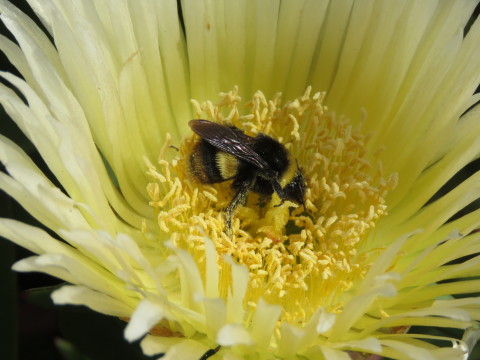The California Department of Fish & Wildlife (CDFW), after being caught out, and losing in court to Grassroots Coalition for illegally draining the freshwater from Ballona Wetlands Ecological Reserve, a site they are entrusted with protecting; CDFW, once again is caught out, in missing the presence of an endangered bee within this very rare, predominantly seasonal freshwater wetland on the coast of Los Angeles, California.
This press release features multimedia. View the full release here: https://www.businesswire.com/news/home/20210525005018/en/

Jonathan Coffin discovers the internationally recognized Endangered Crotch’s Bumble Bee at Ballona Wetlands Ecological Reserve. 5/9/21 (Photo by Jonathan Coffin)
In December of 2020, CDFW green-lighted the conversion of Ballona Wetlands into a full tidal, saltwater bay. Ballona is already home to at least 7 state or federal endangered species and dozens more species that are on California’s List of Species of Special Concern. As part of their approval, they were supposed to have considered the geotechnical issues of that conversion. Now, CDFW admits to their flunked engineering schemes and seeks more money for a do-over. Significantly, their environmental studies were also to include wildlife, both flora and fauna.
Once again, nature photographer Jonathan Coffin has found something important at the wetlands, a Crotch’s Bumble Bee visiting a Sour Fig ice plant flower along the Ballona roadside. “This specific bee is a species on the endangered list of the International Union for Conservation of Nature (IUCN). It’s not a federally protected endangered species, but it does have an international protected status,” cites Coffin, who should be credited for this crucial discovery. “It matters because the current EIR (environmental impact review) for a massive earth moving project missed the presence of this Endangered Bee which they should have known was there. What else did they miss?”
Jonathan’s discovery of the bee was confirmed by entomologist John Asher on iNature, an app sponsored by NatGeo. Asher confirmed the species and the date of April 19, 2021 was recorded for the site. Numerous other species Jonathan's been photographing reveal species existing where CDFW’s, now very stale 2012 studies, don’t. "Since discovering this Bee at Ballona I've gone through my photo archives and found additional photos of the Bee, dating as far back as 2006 that I hadn’t identified. Now, I’m regularly observing and photographing the Bumble Bee visiting the ice plant flowers,” says Coffin.
“I’ve known the Crotch’s Bumble Bee had been recorded at Ballona in the past by reading the 1981 Los Angeles County, Biota of the Ballona Region. That report by Ralph Shreiber is a more extensive survey of the insect life at Ballona. The Crotch’s Bumble Bee wouldn’t have been on the IUCN Red List as endangered when it was recorded in the early 80’s at Ballona.”
“Without human interference Ballona’s ecosystems are making a comeback on their own. Even nonnative, ice plants provide life sustaining water and food, especially during a drought,” says Grassroots Coalition’s, Patricia McPherson. The ice plant has been targeted on CDFW’s get-rid-of list, as environmental organizations maintain vigilance and litigate over failures in oversight by CDFW. Walter Lamb, of the Ballona Wetlands Landtrust, refers to “an ongoing project to rip out non-native ice plant, lacked proper planning or any measurable success criteria and has, as a result, led to the site being largely overrun by even more non-native weedy species. More thoughtful planning is required to protect all of our pollinator species.”
The dispute over Ballona’s future, lies in whether to convert it into something it never was or restore it to its historic nature. Converting it into a saltwater bay via industrial scale bulldozing is sure to destroy numerous species of flora and fauna and pollute its freshwater aquifers, or instead, allow for a gentle restoration that rejuvenates Ballona and preserves its unique biodiversity via a philosophy of first-do-no-harm. The public paid for restoration.
Multiple lawsuits have been filed by environmental groups opposing the CDFW plan, including Grassroots Coalition & Ballona Ecosystem Education Project.
Walter Lamb, a leader in the Landtrust’s litigation, added, “The discovery of a critical species in the wetlands that wasn't analyzed in the environmental impact analysis is another reminder of how complex and dynamic this ecosystem is and highlights the need for a more thoughtful approach to its future management. The current plans were already inadequate in that they fail to protect critical marsh-dependent species from anticipated sea-level rise, fail to protect existing habitat for the endangered Belding’s Savannah Sparrow, rely on errant flood control calculations and many other serious deficiencies.”
Restoration Ecologist Dr. Margot Griswold called the discovery of the bee “significant, because this species was previously documented in surveys conducted in the early 1980’s within the area. Thus, this species persists over at least 40 years within what is left of the historic Ballona Wetlands. The existing biodiversity of the wetlands needs to be valued, and perhaps, should be enhanced and rehabilitated rather than engineered away.”
“The current plan is inconsistent with what we now know. The Plan hasn’t changed much from the mid-2000s, it was tired then and it's tired now. Today, we still have the opportunity to make a better plan. Like the native, Gabrieleno, Tongva people, who called Ballona Pwinukipar (Tongva for ‘is full of water’) their invisibility is shared with our stakeholder invisibility — always providing input but never receiving meaningful response. Instead, let's create a new plan, like the Owens Lake stakeholder master planning process. It won’t be easy, nothing like this usually is, but we still have that opportunity now, to work together and create a better future for Ballona.”
Margot continues, “As a professional restoration ecologist, I argue against the proposed plan presented by the State to create what amounts to a tidal bathtub. Coastal resilience to climate change cannot be created by lowering the land below current sea level. The State’s proposed project would result in the loss of existing diversity, which can be enhanced and revitalized. And, important on a landscape scale, the State’s plan would result in the creation of one more homogenized tidal wetland creation, losing the last remaining diverse coastal wetland.”
Dr. Griswold’s participation as a restoration ecologist in the initially contentious Owens Valley dust control project, reverted to a broad stakeholder inclusive process, leading her to believe that same positive outcome is possible for Ballona, “We should initiate public meetings with interested stakeholders, run by a professional facilitator, create a plan to enhance and revitalize the Ballona wetlands. This type of true public input has been missing from the process.”
Coffin hopes that his discovery can have a positive impact, “A photo I had taken back in May 2020, establishes two consecutive years of Crotch’s Bumble Bee on the Ballona Wetlands and demonstrates a continuity of presence with the earlier 1981 Shreiber Report. I think the IUCN Endangered Crotch’s Bumble Bee discovery today is important because it demonstrates how the current EIR is lacking in protecting existing biological conditions of Ballona today. What else are we missing?”
View source version on businesswire.com: https://www.businesswire.com/news/home/20210525005018/en/
Contacts
Grassroots Coalition
Jeanette Vosburg, Outreach Coordinator, 310-721-3512





